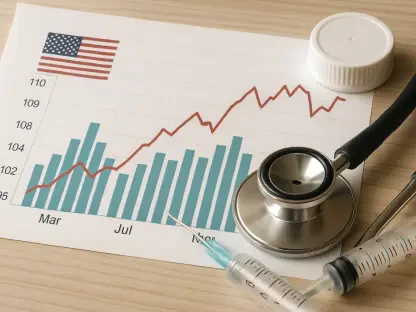Unpacking a Regulatory Roadblock: Why FDA Engagement Matters Now
The medical device industry stands at a critical crossroads in 2025, grappling with an unprecedented challenge as a U.S. government shutdown curtailed the Food and Drug Administration’s (FDA) physical presence at the annual AdvaMed conference in San Diego. This event, a pivotal gathering for medtech stakeholders, typically fosters direct dialogue with FDA officials from the Center for Devices and Radiological Health (CDRH), shaping regulatory clarity and trust. With key figures like the CDRH Director participating only virtually on October 8, and live audience interaction scrapped, the shutdown has exposed vulnerabilities in regulatory engagement at a time when the industry faces mounting uncertainties. This market analysis delves into the implications of this reduced presence, examining current trends in medtech regulation, the financial and operational pressures at play, and projections for how these dynamics might reshape the sector’s future. The stakes are high, as collaboration between regulators and industry players remains essential for innovation and patient safety.
Diving into Market Trends: Regulatory Constraints and Industry Impact
Shutdown Effects: A Barrier to Collaboration
The government shutdown’s impact on the AdvaMed conference signals a broader market trend of external disruptions threatening the medtech sector’s regulatory framework. With FDA officials unable to attend in person, the reformatted town hall—featuring pre-prepared questions rather than live dialogue—limited the spontaneity and depth of discussions that have historically driven consensus on critical issues. This shift underscores a growing risk: without face-to-face engagement, delays in addressing urgent policy or safety concerns could hinder market confidence and slow product approvals. As political uncertainties, including potential staff reductions, loom over the FDA, medtech companies must brace for a landscape where regulatory clarity becomes harder to secure.
User Fee Negotiations: Financial Pressures on the Horizon
Another defining trend in the medtech market revolves around the upcoming Medical Device User Fee Amendments (MDUFA) negotiations, set to establish industry fees from October 2025 to 2032. Sustained investment in the FDA’s programs is crucial to avoid stagnation, especially as the CDRH strives to meet device review goals despite constrained resources. However, tensions persist over fee structures, with some industry groups pushing for flat fees while others remain silent on specific demands. The outcome of these talks could significantly influence market dynamics, affecting everything from innovation budgets to approval timelines. Companies that fail to engage early in this process risk facing unexpected cost burdens, potentially stifling smaller players in a competitive field.
Safety and Technology: Balancing Innovation with Oversight
On the product front, the medtech market is witnessing a dual focus on safety enhancements and technological advancements, even amid regulatory strain. Efforts to expand early alert programs for faster recall communication and to boost adoption of Unique Device Identifiers (UDIs) aim to strengthen post-market surveillance, though uptake by hospitals and payers remains sluggish. Simultaneously, artificial intelligence (AI) is emerging as a transformative force, with progress toward lifecycle management guidance and discussions on generative AI in digital mental health devices shaping future offerings. Yet, the cautious integration of AI—emphasizing human oversight—reflects a market tension between rapid innovation and the need for robust safeguards, a balance that will define competitive edges in coming years.
Forecasting the Future: Medtech Regulation and Market Shifts
Policy and Economic Uncertainties: A Looming Challenge
Looking ahead, the medtech market faces potential disruptions from policy shifts and economic pressures that could alter regulatory landscapes. Changes under the current administration, including possible tariff increases, may impose new financial strains on device manufacturers, impacting pricing strategies and market access. Projections suggest that without proactive dialogue, these external factors could exacerbate existing resource shortages at the FDA, leading to slower review processes. Companies must anticipate such scenarios by diversifying supply chains and advocating for policies that stabilize funding, ensuring they remain agile in a volatile regulatory environment.
Technological Integration: AI as a Market Game-Changer
The integration of AI into both regulatory processes and medical devices is poised to be a dominant market driver, with internal tools at the CDRH signaling a gradual embrace of automation under strict controls. Forecasts indicate that AI could streamline review efficiencies and enhance product capabilities, particularly in personalized healthcare solutions, over the next five years. However, market players must navigate the FDA’s measured approach, prioritizing compliance with evolving guidance to avoid costly missteps. Early adopters who align with regulatory expectations stand to gain significant market share, positioning themselves as leaders in a tech-driven future.
Funding Outcomes: A Litmus Test for Industry Growth
The resolution of MDUFA negotiations will serve as a critical indicator of the medtech market’s growth trajectory through 2032. Analysts predict that sustained or increased funding levels for the FDA could accelerate innovation cycles by ensuring timely reviews and robust safety programs. Conversely, inadequate resources may bottleneck approvals, disproportionately affecting smaller firms with limited capital to weather delays. Market projections hinge on collaborative outcomes—stakeholders who actively shape fee agreements and advocate for balanced investment will likely fare better in maintaining competitive momentum amidst regulatory flux.
Reflecting on Insights: Strategic Pathways Forward
Looking back on the analysis of the FDA’s limited engagement at the AdvaMed conference, it became evident that the government shutdown posed a tangible barrier to regulatory collaboration, amplifying existing uncertainties in the medtech sector. The examination of trends like user fee negotiations, safety initiatives, and AI integration revealed a market at a pivotal juncture, balancing innovation with operational constraints. For industry stakeholders, the path forward involves strategic actions: engaging proactively in funding discussions proves essential to secure favorable terms, while investing in compliance with UDI and AI frameworks offers a way to stay ahead of regulatory curves. Building resilient communication channels, even in virtual formats, emerges as a practical step to maintain dialogue with the FDA during crises. These efforts, grounded in adaptability, chart a course toward navigating the complex regulatory landscape, ensuring that challenges transform into opportunities for sustained growth and patient impact.









